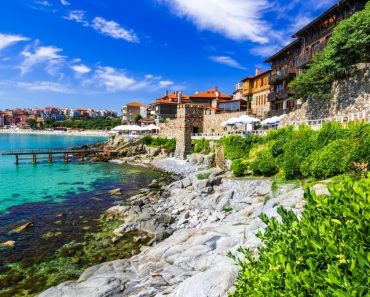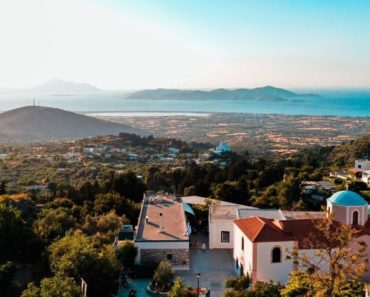This article was produced by National Geographic Traveller (UK).
Surrounded by baby clothes and frilly cardigans, it’s hard to believe I’m here to learn about Greek history. But beneath the children’s department of Zara on Stadiou Street lie the remnants of a Roman tomb. There isn’t a label or signpost in sight. Nothing to say who built it, why it’s here or when it was discovered. Above my head is a reinforced glass panel, on which dozens of shoppers unwittingly walk over a mysterious, most likely 2,000-year-old artefact.
“Athens is a very alive city,” says Tina Kyriakis, flipping her thick, brown ringlets from her face. Born in the southern suburbs, my guide for the day is founder of the tour companies Alternative Athens and Back to the Routes. “Look at the city as a living organism,” she says. “We don’t think, ‘OK, let’s build on top of or repurpose this building’ — it’s just a continuity of life, a natural progression. It’s not intentional.”
It’s this progression that’s led to Athens revealing itself in layers. Think of it as an architectural moussaka. At the bottom are remnants of the ancient city dating back to the fifth century BCE, tucked underneath Metro stations, clothes shops and residential buildings. In the middle, a mixture of its Roman, Byzantine, Ottoman and neo-classical past. And, finally, 21st-century Athens, the bechamel sauce in this analogy, sits on top of everything that came before.
(The 31 best Greek islands to visit in 2024.)

Once a hub of thriving commercial activity, the Roman Agora — located in Monastiraki — was the beating heart of Athens. Photograph by Marco Argüello

Built in the archaeological site of the Ancient Agora, Stoa of Attalos houses historic artefacts such as the head of Nike, the Greek goddess of victory. Photograph by Marco Argüello
As for this tomb, Tina can’t tell me much about it. What we do know is that the building under which it’s built was likely constructed sometime in the late 19th century and once belonged to philanthropist Ioannis Hadjikyriakos. Since then, it’s been a hotel, an army base, offices and, now, a clothing store. And the glass panel isn’t here because the construction workers had a soft spot for Greek antiquity. Rather, it’s enshrined in law, says Tina. The Greek government stipulates that to build on top of ancient relics, they must be left ‘viewable and visitable’. She’s been to houses in Plaka — one of the oldest neighbourhoods in Athens — where dining tables sit on top of glass panels overlooking all sorts of artefacts. It doesn’t matter if it’s private property — if it’s old, it must be on display.
Athens has been continuously inhabited since the mid-late Neolithic era, around 3000 BCE, so it makes sense that old and new co-exist here. “It doesn’t matter where you dig, you’ll always hit something,” Tina tells me. “What are we supposed to do? Not build?”
A five-minute walk leads us to Aiolou Street, where Tina shows me another stark dialogue between old and new. The National Bank of Greece Administration Building — just off Kotzia Square — is made with sand-coloured poros stone and black, unpolished granite. It sits virtually on top of remnants of the city’s fifth-century BCE walls, which once enveloped the Acropolis, the Agora public space and the Temple of Zeus. Finished in 2002, the bank was built so that the remains were left out in the open and visible from a viewing platform just by the entrance.
The Kotzia Square area was excavated between 1985 and 1988 to make way for an underground car park. Three ancient streets, a cemetery and a complex of houses and workshops were unearthed before the car park plans were scrapped. When they started building the Administration Building, the architects were very conscious of the heritage surrounding it. “You see how the modern blocks mimic the style and shape of the ancient foundations just below it? It’s a very conscious decision — we had to work around it,” says Tina.

The pedestrianised Dionysiou Areopagitou Street, at the foothills of the Acropolis, passes through museums and archaeological monuments. Photograph by Marco Argüello

Located in Monastiraki, visitors to Cava Nektar can enjoy hand-crafted cocktails before perusing locally sourced wines and spirits in the store’s deli. Photograph by Marco Argüello
Our last stop for the day is Monastiraki Metro Station, one of the busiest in Athens. We take a lift down to platform level, where a glass walkway overlooks an archaeological site excavated during the station’s construction. The remains, ranging from the eighth century BCE to the 19th century, are mostly settlements, and a small gap between the relics and the information board above reveals the trickling remnants of the Eridanos River.
“Look at how the city gradually rises. Each period built on top of the other?” Tina says, pointing to the earliest relics — a mishmash of rocks just a few inches off the ground. “It starts with the early Christian era and just keeps rising. Look at the difference between the 8th century and the 19th,” she continues, gesturing to mammoth blocks of stone dating to the 1800s. “What a coexistence that is!”
Odeons past and present
The following evening, just before sunset, I head towards the open-air theatre Odeon of Herodes Atticus, aka ‘Herodeon’, to watch renowned Greek composer and conductor Michalis Economou and the ERT National Symphony Orchestra commemorate World Music Day. The event is part of the annual, three-month Athens Epidaurus Festival, in which the city comes alive with musical performances and theatre.
The semi-circular, 5,000-seater Herodeon stands staunchly on the southwest side of the mighty Acropolis and was built by Athenian rhetorician Herodes Atticus in 161 CE, a date my heat-dilapidated mind — it’s 9pm and 30C — struggles to comprehend. How is it still here? Did Herodes think it would stand this long? And do the teenagers taking selfies in the corner know that this is the place second-century traveller and geographer Pausanias described as ‘the finest building of its type’?
The evening light gives my surroundings a pretty, candlelit effect, especially the ubiquitous cypress trees and millenia-old arches of the changing area behind the stage.

Within the walls of Odeon of Herodes Atticus, a 2,000-year-old open-air theatre, visitors can enjoy a variety of music, and theatre performances. Photograph by Marco Argüello
I climb the steep steps to the top and take my seat. Within seconds, luminescent fireflies dart in front of me, as if they’re part of the show. The chirps of cicadas and crickets blend with the murmurings of the audience.
The chequerboard stage is backlit with orange and purple lights. I suddenly spot the full moon between a cypress tree and what’s left of the second-storey arch. The solitary stone Philopappos Monument — a mausoleum built in the 2nd century — is poised on Mouseion Hill to the south, and looks almost computer-generated against the cerulean sky. It’s mesmerising enough just to sit here, before the show has even started.
Herodeon’s architecture is typically Roman, with elaborate arches and a two-storey, semi-circular orchestra pit. In the 1950s, it was restored using Pentellic marble from Mount Pentelicus, the same material used to build much of the Acropolis. Since then, it’s continued to serve its original purpose: entertainment. Pavarotti, Frank Sinatra, Elton John and Sting have all performed here, and Coldplay recently shot their video for Feels Like I’m Falling in Love inside the historic venue.
Suddenly, the lights dim and the orchestra takes to the stage. The audience falls silent. The sedative plinks of the violin open the show, and soon the bows dance in unison. For the next few hours, we’re treated to orchestral works by the likes of Shostakovich, Tchaikovsky and Chopin, drawing to a close around 11pm. I gingerly make my way down the steps and onto the leafy promenade Dionysiou Areopagitou, where I spot the maestro Economou himself. Dressed in a black tunic suit and with a head full of short, tight curls, it’s easy to single him out from the crowd.
I chase him as he hurries through the throng of people, eventually cornering him behind a vendor. I’m desperate to know how it feels to perform at such a remarkable venue. “It’s a disaster,” he tells me. “Playing classical pieces in open theatres is very difficult — the losses are very practical; the trumpets cannot hear the strings, for example. I definitely prefer closed theatres, the orchestra sounds much better.”
“But this place obviously has such a magical aura,” he continues, “and this kind of balances out the losses. The energy of this place, combined with art, is out of this world.”
I ask him if he thinks it’s important to keep the culture of amphitheatres alive and he tells me that their preservation is not up to us. “These are monuments,” he says, “and only history and time decides what survives and what doesn’t.”

Just shy of the Acropolis, Philopappos Hill offers sweeping views of the Greek capital. Photograph by Marco Argüello
The next evening, I head towards the leafy, upscale neighbourhood of Kolonaki in central Athens, for a screening of the 2023 film Memory at Cine Dexameni. The open-air cinema has been here since 1905 and is one of around 65 in the city, scattered around parks, wedged in between leafy residential blocks and, in this case, built on top of a Roman aqueduct constructed 2,000 years ago. Athenians — some old, others young, some dressed up to the nines, others super casual — make their way up the black-and-white slate stairs towards their seats.
The last time I was here, the aqueduct completely passed me by — but not tonight. I grapple with the gate to it but, to my horror, it’s closed because the tank needs maintenance.
I peep through to catch a glimpse of something that provided Athenians with their water until around the mid-20th century. Through one of the windows, I can just about make out the stone columns and arches of the aqueduct, illuminated by ground spotlights. Eventually, I accept defeat and head upstairs, where I’m met with the smell of pine and hot, buttery popcorn.
With a large bottle of Mythos lager in my hand, I take a seat right at the back. It’s the perfect summer’s evening. When the film starts, I wonder who else here is unaware of the history that’s present just a few inches below actor Jessica Chastain’s face. And I think back to something my guide Tina told me earlier in the week: “If we get out of our Greekality and look at it from the eyes of a stranger, Athens is a very mind-blowing place.”
Kirker Holidays offers a three-night stay at St George Lycabettus based on two sharing a room, including return flights, breakfast, private transfers, entrance tickets to the Acropolis and the Acropolis Museum, and the services of the Kirker Concierge. From £776 per person.
Getting there & around:
Operators including Aegean Airlines fly direct to Athens from London, Manchester, Newcastle and Edinburgh. Average flight time is 3 hours 40 minutes.
It’s possible to explore most of Athens’ major sites on foot, although you should wear comfortable shoes for tackling hills and uneven ground. The fastest way to reach places further afield is the Metro, which runs daily from 5am until midnight. The green line connects Kifisia in the north to the port of Piraeus, the red line connects west and south Athens, and the blue line will take you to all the central stations including Monastiraki and Syntagma. Yellow taxis are readily available and can be ordered via Uber and Free Now. The bus system takes you almost anywhere in the city.
When to go:
Athens can get stiflingly hot between May and September, occasionally reaching temperatures near or above 40C. March and April and September and October are the most pleasant times to visit, when the temperatures are cooler and there are fewer crowds.
Where to stay:
Brown Acropol, Omonia district. Doubles from €140 (£118), B&B.
More info:
visitgreece.gr
The Mini Rough Guide to Athens. £7.99
This story was created with the support of Greek National Tourism Organisation.
To subscribe to National Geographic Traveller (UK) magazine click here. (Available in select countries only).







